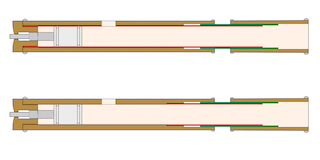Options
A number of options are available for my flutes.
Keys
I'm working with an external key maker for supplying flutes with up to eight keys. The keys are mounted on metal pillars, which is state of the art in woodwind instrument making. The available standard keys are, sorted by usability in irish music:

- G#
- F long
- Bb
- Eb
- C natural (high)
- F short
- low C#
- low C
Supplying custom keywork, i.e. to accomodate for piper's grip, or for a low B, is possible, too. Contact me to discuss your requirements.
Fully or partially lined Headjoint

My flutes can be supplied with a fully lined headjoint, or with a partially lined headjoint. On the partially lined headjoint, the liner ends about 40mm before the embouchure hole. Tone-wise, it doesn't make a difference in my ears, but that's surely only my point of view. A partially lined headjoint is much less likely to develop a crack over time than a fully lined headjoint, which is due to the liner only touching a minimal part of the wood, thus allowing it to move freely. Furthermore a partially lined headjoint is much lighter than a fully lined one, which gives a considerabily better balance, especially on keyless flutes. On six-or-more-keyed flutes it can be a good thing to have a fully lined headjoint due to the better overall balance.
Fully and partially lined headjoints costs the same, however a fully lined headjoints needs more time for seasoning, as I have to watch the timber closely to predict how it will move over time. The liner is not glued into until the timber has stopped moving. That may cause a longer waiting time.
Screw Cork Mechanism

Every flute has a cork (or "stopper") in its head joint, making sure that part of the instrument is air-tight. The "face" of the cork needs to be at a specific distance from the center of the embouchure hole - a "standard value" for that distance is 19mm, which is the inner diameter of the head joint. However the optimal distance also depends on the player and his or her day form. I personally prefer the cork to be at around 16 - 18mm, other players want it at 25 mm. If you have a flute with a regular head joint cork, you need a wooden stick to move the cork to a different position, after disassembling the flute. Plus, that can damage the cork over time, especially if a non-suitable stick (like a tin whistle!) is used.
I can supply a screw cork mechanism which allows the player to change the cork's position by turning the head joint crown. A metal indicator pin (nickel silver or brass) shows the cork position. The name "Screw Cork" is a bit misleading, though - the stopper is made from Delrin, which by the way is completely immune to moisture.
Having a screw cork mechanism isn't a must, but it can be handy from time to time.
Artistically designed Headjoint Crown

I can make a artistically design headjoint crown upon request. I normally use different contrasting timbers, silver rings and paua shell inlays, but all sorts of different combinations are possible: only one ring and contrasting timber, two different timbers instead of paua shell, gold rings, or many more. Two designs are pictured on the right, and this PDF file lists a few more standards designs - but I am also happy to design your very own crown!
It is also possible to combine the designed crown with a screw cork, either with indicator pin or without.

